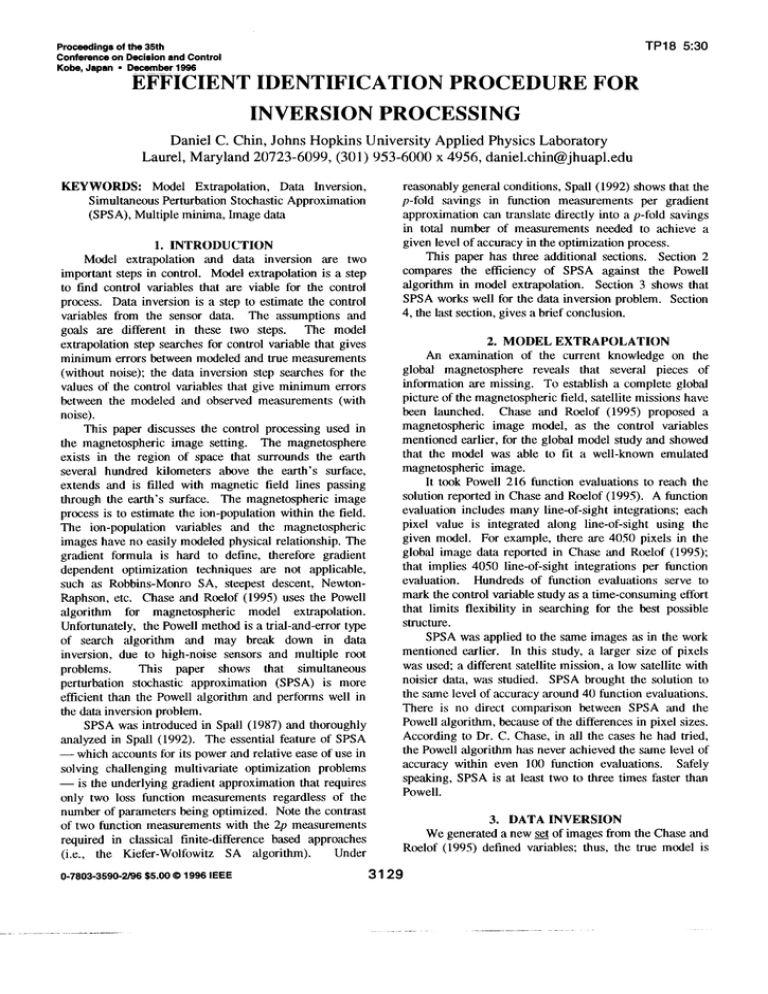EFFICIENT IDENTIFICATION PROCEDURE FOR
advertisement

Proceedings of the 35th TP18 Conference on DeoieionandControl Kobe, Jepan Daoarnbar 1996 5:30 ● EFFICIENT IDENTIFICATION INVERSION Daniel C. Chin, Johns Hopkins Laurel, Maryland 20723-6099, University (30 1) 953-6000 Applied Physics Laboratory x 4956, daniel.chin@jhuapl. edu reasonably general conditions, Span (1992) shows that the p-fold savings in function measurements per gradient approximation c,an translate directly into a p-fold savings in total number of measurements needed to achieve a given level of accuracy in the optimization process. This paper has three additional sections. Section 2 compares the efficiency of SPSA against the Powell algorithm in model extrapolation. Section 3 shows that SPSA works well for the data inversion problem. Section 4, the last section, gives a brief conclusion. 1. INTRODUCTION Model extrapolation and data inversion are two important steps in control. Model extrapolation is a step to find control wwiables that are viable for the control process. Data inversion is a step to estimate the control variables horn the sensor data The assumptions ,and goals are different in these two steps. The model extrapolation step searches for control variable that gives minimum errors between modeled and true measurements (without noise); the data inversion step searches for the walues of the control variables that give minimum errors between the modeled and observed measurements (with noise). This paper discusses the control processing used in the magnetospheric image setting. The magnetosphere exists in the region of space that surrounds the earth several hundred kilometers above the earth’s surface, extends and is filled with magnetic field lines passing through the earth’s surface. The magnetospheric image process is to estimate the ion-population within the field. The ion-population variables ,and the magnetospheric images have no easily modeled physical relationship. The gradient formula is hard to define, therefore gradient dependent optimization techniques are not applicable, such as Robbins-Monro SA, steepest descent, NewtonRaphson, etc. Chase and Roelof (1995) uses the Powell algorithm for magnetospheric model extrapolation. Unfortunately, the Powell method is a trial-and-error type of search algorithm and may break down in data inversion, due to high-noise sensors and multiple root problems. This paper shows that simultaneous perturbation stochastic approximation (SPSA) is more efficient than the Powell algorithm and performs well in the data inversion problem. SPSA was introduced in Span (1987) and thoroughly ,analyzed in Span (1992). The essential feature of SPSA — which accounts for its power ,and relative ease of use in solving challenging multiv,ariate optimization problems — is the underlying gradient approximation that requires only two loss function measurements regardless of the number of parameters beiig optimized. Note the contr,ast of two function measurements with the 2p measurements required in classical finite-difference based approaches (i.e., the Kiefer-Wolfowitz SA algorithm). Under $5.00 @ 1996 IEEE FOR PROCESSING KEYWORDS: Model Extrapolation, Data Inversion, Simultaneous Perturbation Stochastic Approximation (SPSA), Multiple minima, Image data 0-7803-3590-2/96 PROCEDURE 2. MODEL EXTRAPOLATION An examination of the current knowledge on the global magnetosphere reveals that several pieces of information are missing. To establish a complete global picture of the magnetospheric field, satellite missions have been launched. Chase and Roelof (1995) proposed a magnetospheric image model, as the control variables mentioned earlier, for the global model study and showed that the model was able to fit a well-known emulated magnetospheric image. It took Powell 216 function evaluations to reach the solution reported in Chase and Roelof (1995). A function evaluation includes m,any line-of-sight integrations; each pixel vahre is integrated along line-of-sight using the given model. For example, there are 4050 pixels in the global image data reported in Chase and Roelof (1995); that implies 4050 line-of-sight integrations per function evahration. Hundreds of function evaluations serve to mark the control variable study as a time-consuming effort that limits flexibility in searching for the best possible structure. SPSA was applied to the same images ,as in the work mentioned earlier. In this study, a larger size of pixels was used; a different satellite mission, a low satellite with noisier data, was studied. SPSA brought the solution to the same level of accuracy ,around 40 function evaluations. There is no direct comparison between SPSA and the Powell algorithm, because of the differences in pixel sizes. According to Dr. C. Chase, in all the cases he had tried, the Powell algorithm has never achieved the same level of accuracy within even 100 function evaluations. Safely speaking, SPSA is at least two to three times faster than Powell. 3. DATA INVERSION We generated a new ~t of images from the Chase ,and Roelof (1995) defined variables; thus, the true model is 3129 — .. known. A random noise is also added to each image pixel to mimic the real data, named mimic da~l. The noise level statistic of 10 Poisson counts per pixel was used, that being the noise level in the collected data. The data image looks like the one shown on Ftgure 1.d in Chase ,and Roelof (1995). We then applied the SPSA algorithm to estimate the variables starting from a set of nominal values. The variables were the upper or lower bounds for the shape variables and constants for the angular variables. The SPSA results are shown by the two curves in Figure 1 that ,are residuals between estimated ‘and truth values at each SPSA iteration. Both residuals are computed in square-sum form ,and normalized by the prior residuals. One residual curve is the difference between the pixel images generated from estimated parameters and the mimic claw, the other is the difference between the estimated model parameters and the model pam.meters used to generate the mimic data The image residual curve shows a 94% drop, i.e., from an error-square-sum value of 6.73 to a value of 0.40. The model residual curve shows a 50% reduction rate, horn the error-squ,are-sum value of 1.78 to value of 0.89. Among the estimated model parameters, some of them match the truth values to the second digit; the others moved in-between the true and prior values, or even stayed around the prior values. We m:iy have to redefine the model structure to have all the parameters converge at the same speed because of The parameter identifiability ,and observability issues. zero pixels surrounded by the sharply raised population pixels, and then it drops off to zero and stays zero on the rest of the pixels. There are no problems in estimating the parameters representing the shape in the ion concentrated The difficulty is to estimate those parameters area. representing the low density images located in the area before the ion population drops off to zero. The original loss function used in Chase and Roelof (1995) tends to overlook these low density images. Therefore, instead of using the lumped global error loss function as the one used in Chase and Roelof (1995), a loss function th:it emphasizes individual pixels is used (for the study of Figure 1), thereby providing better estimates of low density pixel parameters. 4. CONCLUSION This study has shown that with SPSA, the rate of convergence increases dramatically (relative to the Powell algorithm) due to a decrease from hundreds of function evaluations to tens (each function evaluation represents costly global line-of-sight integration). It greatly increases the flexibility of potential model variable study due to the shortening of the computer turn-around time. Most importantly, the SPSA algorithm has shown that it can be used very successfully for the data inversion, i.e., where observability is adequate. This kmd of success has not been shown with any other optimization algorithms that have been applied in the magnetospheric setting. The next step for this magnetospheric image problem is to process the real data collected tlom a flown satellite mission and then to estimate the ion-population. errors come ffom two error sources, the error from the estimation process ,and the error from the model disturbances due to the finite sample data. Nevertheless, this application shows that the SPSA algorithm can be used for the inversion problem. ACKNOWLEDGMENT: The paper is jointly supported by the JHU/APL JR I% D program and NASA SR A T progr,am, Contract #NAGW2691. Also, the author appreciates the help tlom Drs. R. H. Smith and C. J. Ch,ase. REFERENCE: 0 5 10 15 20 [1] Chase, C. J. and Roelof, E. C., 1995, “Extracting Evolving Structures from Global Magnetospheric Images via Model Fitting ,and Video Visualization,” Johns HorJkins APL Technical Digest, v. 16, no. 2, pp. 111-122. 25 ITERATIONS Figure 1: Residual Errors and Global Image in Parameter Global [2] Chin, D. C., 1994, “A More Efficient Optimization Algorithm Based On Styblinski ‘and Tang:’ Neural Networks, v. 7, pp. 573-574. Estimation [3] Span, J. C., 1987, “A Stoch~stic Approximation Technique for Generating Maximum Likelihood Parameter Estimates,” proceedings of the American Control Conference, pp. 1161-1167. In this study, two optical problems have been overcame in estimation of the magnetospheric image parameter values: multiple representations and boundary values. The multiple representation problem is the local minimum problem that was handled by using the stepped SPSA gain sequence as described in Chin (1994). The boundary value problem arises from the fact that the images of the magnetospheric ion populations have distinct features. The image at the pole area h,as several “Multivariate Stochastic [4] Span, J. C., 1992, Approximation Using A Simultaneous Perturbation Gradient Approximation,” IEEE Transactions on Automatic Control, v. 37, pp. 332-341. 3130 . .. . ..—._.. . .— —-——.



